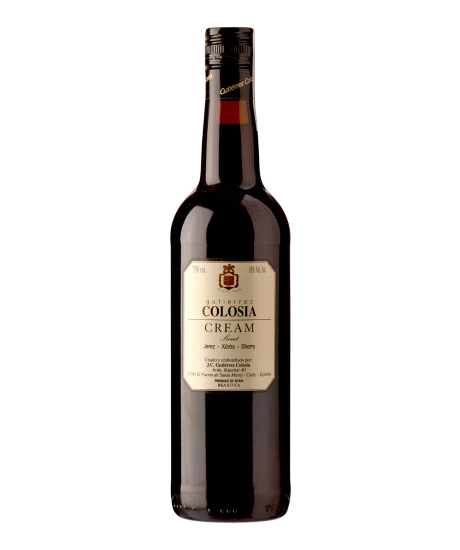
Sherry Cream
DO Jerez, Gutiérrez Colosía, 750 ml

| Grape variety: | Palomino, Pedro Ximénez |
| Producer: | Gutiérrez Colosía |
| Origin: | Spain / Sherry |
Description
This sweet sherry offers everything you would expect from a cream: a bouquet of dried figs, plums and chocolate. The palate is round, full-bodied and very harmonious with a long finish. Sweet sherry can be so beautiful!
Attributes
| Origin: | Spain / Sherry |
| Grape variety: | Palomino, Pedro Ximénez |
| Drinking temperature: | 12 to 14 °C |
| Vinification: | soft pressing, fermentation in wooden barrel |
| Harvest: | hand-picking, in small boxes, drying of the grapes |
| Maturation: | in tonneau |
| Volume: | 18.0 % |
| Note: | Contains sulphites |
Pedro Ximénez
Liquid raisins
If you saw the white grapes, you would not suspect it, but white wines from Pedro Ximénez taste like liquid raisins. This variety is a genuine Andalusian. It has been known since the 17th century, and was probably named after a winery called Pedro Ximénez – the name is as common in southern Spain as Jones or Smith is to us. Its stronghold is in the Montilla-Moriles cultivation area. There, the sugar-rich grapes are traditionally dried on mats of esparto grass. Thus they lose their moisture, and the sugar concentration rises. Experts simply refer to the resulting sweet, nutty, coffee- and cocoa-spiced elixirs as PX. There is also a PX version of sherry. Nonetheless, most sherry houses do not grow the Pedro Ximénez themselves, but purchase them in Montilla-Moriles. One also seldom encounters the Pedro Ximénez as a dry white wine. Yet it does not present a great deal of profile.

Palomino
The knight of the grapes
In its native Andalusia, this white autochthonous variety occupies over 90% of the vineyard area. Worldwide, around 60,000 hectares are planted with Palomino. It can also be found in South Africa, France, Argentina, Australia, the United States (California), New Zealand and Cyprus.
Its clusters grow astonishingly large, and can reach a weight of over two kilograms. The golden berries are quite resistant to pressure and extremely aromatic, which is why Palomino are also sold as table grapes.
Its name derives from the Spanish knight Palomino, who became famous in the 13th century in the service of King Alfonso X for his performance as a fighter.

Spain
Spain – Variety and perfection
“Somewhere in la Mancha, in a place whose name I do not care to remember...,” begins Don Quixote's odyssey.
The most famous part is definitely when Don Quixote thinks windmills are his enemy and wants to fight them – until they nearly kill him. It’s possible there was a bit too much of the La Mancha wine at play. Spanish vines fight for their survival in rugged landscapes, battling fierce drought and rough soils. But they fight well.



